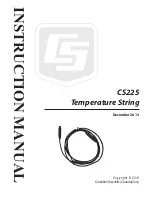
17
AIM-4SL Hardware Manual
© 2011 Apollo Security Inc.
3.4
RS-485 Communications Line
The typical connection for field devices (such as the AIM-4SL) on a device port with an Apollo AAN/AAM
controller is through an RS-485 serial communication line. First, for communication to be possible, the
device port must have a communications driver installed in the corresponding socket (see Part 2.3). For
RS-485, the ASM-48 Communications Driver module is required. If it is necessary to use RS-232 to connect
a device to the AAN-100, contact your Apollo technical support representative for more information.
Overview: The RS-485 standard is an electrical interface for multi-point communication on bus transmission
lines. It allows high speed data transfer over extended distance (4000 ft, 1219 m). Unlike the RS-232C or
current loop interfaces, the RS-485 interface allows multiple devices to communicate at high data rates on a
single cable, over long distance. Obviously, the RS-485 interface provides advantages in cost saving for
installation and improved system performance, but it also brings about issues which would not commonly be
seen on systems using RS-232C or current loop interfaces.
Bus Configuration: Communication cables for RS-485 should be laid out in a "Bus topology". This means
that there should only be two ends to the line and devices should be located directly along this line or (as an
exception) on short drops coming from the main line (10 feet max.). The controller can be located at any
point along the line (See Figure 3.4.1.1). Long stubs (T connection) should be avoided because they create
discontinuities and degrade signals. DO NOT connect devices in ‘star’ configuration. A star connection
creates long stubs and causes difficulty in cable termination. The maximum number of field devices on one
RS-485 communications bus is 32. Each field device must have a unique address, and all the devices must
use the same baud rate, typically 9600bps (both set by the device’s DIP switches, and should have the same
corresponding settings in the host software).
Signal Ground: Using long communication cable with multiple devices often necessitates powering devices
from different power sources. This can result in ground faults, which can cause communication problems
and possible equipment damage. Because the RS-485 interface communicates in the base band and
provides no DC isolation, ground fault places devices at different electrical ground levels and causes large
ground currents to flow. The possibility of ground fault makes it necessary for careful system planning and
installation verification. The signal ground (SG) provides a common mode signal reference for the
communicating devices. Each device must connect its SG to the cable shield drain wire. Failure to use the
SG connection may cause communication error. If the environment is known to be electrically noisy, an
additional wire may be used for the signal ground, and the shield can be then grounded as an electric noise
shield.
Termination: Longer communication cable can also create noise and signal reflection problems if proper
cable is not used or if the cable is not correctly terminated. Therefore, RS-485 must be terminated at both
ends. Terminating the line provides more reliable communication by minimizing signal reflection and
external noise coupling. The factory recommends AC termination to minimize DC loss. Terminator
assemblies with screw terminals (ATM-48, P/N 470-030) are recommended for installation convenience.
Device Wiring: Typical RS-485 consists of four wires: Positive Receive (R+), Negative Receive (R-),
Positive Transmit (T+), Negative Transmit (T-), and Signal Ground (SG). The controller will serve as
“Master” on the line and the other field devices (such as the AIM-4SL) as “Slaves”. There can only be one
master per line. The transmit lines of the MASTER device are connected to the receive lines of the SLAVE
devices and the receive lines of the MASTER device are connected to the transmit lines of the SLAVE
devices.
Содержание AIM-4SL
Страница 6: ...Part Introduction I ...
Страница 9: ...Part Hardware Layout II ...
Страница 19: ...Part System Wiring III ...
Страница 36: ...Part Troubleshooting IV ...
Страница 38: ...Part Specifications V ...
Страница 40: ...Part Supplemental Figures VI ...
Страница 41: ...36 Supplemental Figures 2011 Apollo Security Inc 6 Supplemental Figures ...
Страница 42: ...37 AIM 4SL Hardware Manual 2011 Apollo Security Inc ...
Страница 43: ...38 Supplemental Figures 2011 Apollo Security Inc ...
Страница 44: ...39 AIM 4SL Hardware Manual 2011 Apollo Security Inc ...
Страница 45: ...40 Supplemental Figures 2011 Apollo Security Inc ...
Страница 46: ...41 AIM 4SL Hardware Manual 2011 Apollo Security Inc ...
Страница 47: ...42 Supplemental Figures 2011 Apollo Security Inc ...
Страница 48: ...Part Table of Figures VII ...
Страница 50: ...Part Revision History VIII ...
















































